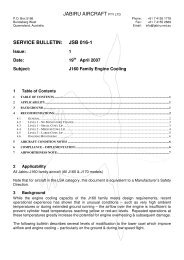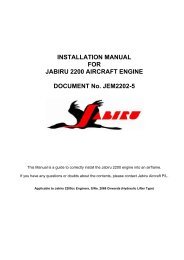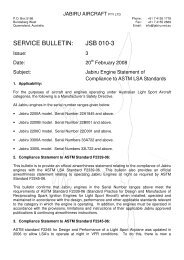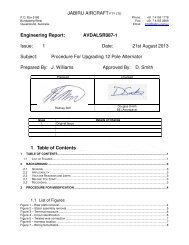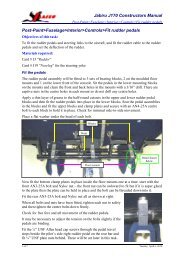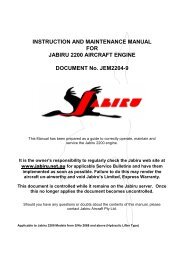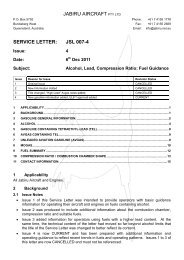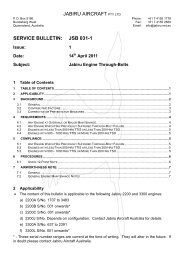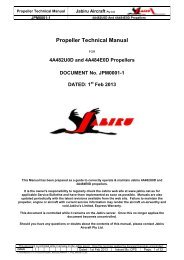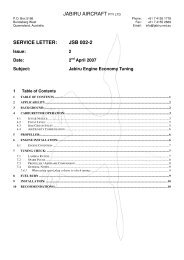JSB 019-2 - Jabiru Aircraft
JSB 019-2 - Jabiru Aircraft
JSB 019-2 - Jabiru Aircraft
You also want an ePaper? Increase the reach of your titles
YUMPU automatically turns print PDFs into web optimized ePapers that Google loves.
JABIRU AIRCRAFT PTY LTDP.O. Box 5186 Phone: +61 7 4155 1778Bundaberg West Fax: +61 7 4155 2669Queensland, Australia. Email: info@jabiru.net.auSERVICE BULLETIN: <strong>JSB</strong> <strong>019</strong>-2Issue: 2Date: 24 th November 2010Subject:Control Surface ClearanceIssue Reason for Issue Issue Status1 Original Issue CANCELLED2 Include recurring inspection requirements, clarify acceptance criteria CURRENT1 APPLICABILITY .................................................................................................................................................. 12 BACKGROUND: .................................................................................................................................................. 12.1 GENERAL: ..................................................................................................................................................... 12.2 DETAILS FOR ISSUE 2: ................................................................................................................................... 23 INSPECTIONS: .................................................................................................................................................... 33.1 INSPECTION A: ............................................................................................................................................... 33.2 INSPECTION B: ............................................................................................................................................... 33.3 INSPECTION C: .............................................................................................................................................. 54 RECOMMENDATIONS: ...................................................................................................................................... 65 COMPLIANCE – IMPLEMENTATION SCHEDULE: .......................................................................................... 65.1 REPORTING ................................................................................................................................................... 66 AIRWORTHINESS NOTE: .................................................................................................................................. 61 ApplicabilityAll <strong>Jabiru</strong> <strong>Aircraft</strong>.Note: For aircraft in Light Sport <strong>Aircraft</strong> categories this Bulletin is equivalent to aManufacturer’s Safety Direction.2 Background:2.1 General:In early 2008 this bulletin was first released to address several cases where the controlsurfaces of <strong>Jabiru</strong> <strong>Aircraft</strong> have rubbed against fixed parts of the airframe during flight. Insome cases this lead to the control jamming. Figure 1 illustrates a typical control in both thenormal (shown at left) and jammed (shown at right) positions.Since this bulletin was first released these incidents have continued to occur, though at alower rate. In some cases these incidents have lead to a loss of control of the aircraft,resulting in significant damage.
2.2 Details For Issue 2:<strong>Jabiru</strong> Service Bulletin: Control Surface Clearance<strong>JSB</strong> <strong>019</strong>-2 24th November 2010 This bulletin is being re-released now with new requirements intended to prevent furtherrecurrence of this type of problem. The aircraft Technical Manuals are also being updated toinclude additional recurring inspections of the control system. Issue 1 of this bulletin has been cancelled and replaced by Issue 2. Issue 1 must no longerbe referenced during maintenance. In Figure 1 several terms used throughout this bulletin are defined. This definition isprovided to clarify the statements given in the remainder of this bulletin.Control – This refers to control surfaces – rudder, elevator and ailerons.<strong>Aircraft</strong> – This refers to the fixed part of the aircraft immediately in front of the controls. Inparticular it refers to the point indicated in Figure 1, where the control will hit the aircraft if ajam occurs.Control at the point of overlap – This is the particular point where the rearmost edge of theaircraft is aligned with the front of the non-hinged side of the control. This is the critical pointwhere a control jam becomes possible. Any control which has a critical overlap of less than2mm should also be treated as having a “point of overlap” as defined by this bulletin.Control clearance – This is the working clearance between the control and the aircraft.Control gap – Best shown on Figure 3 (left). If the control passes the point of overlap a gapopens between the aircraft and the control. A gap like this combined with excess flexing ofthe control surface hinges will lead to control surface jamming.“<strong>Aircraft</strong>” – in thiscase the wing.“Control at the point ofoverlap” – rear edge ofaircraft lines up with thefront of the non-hingedside of the control.“Control” – in thiscase an aileronJammed control –excess hinge deflectionwith the control at thepoint of overlap resultsin jamming.“Controlclearance”Figure 1 – Normal and Jammed Control Illustration<strong>JSB</strong><strong>019</strong>-2.docx Page 2 of 6
3 Inspections:3.1 Inspection A:<strong>Jabiru</strong> Service Bulletin: Control Surface Clearance<strong>JSB</strong> <strong>019</strong>-2 24th November 2010 This inspection is to check if the controls are configured in such a way that there is a point ofoverlap as shown in Figure 1. At noted above the point of overlap is the critical point atwhich severe control jamming becomes possible. Check each control by moving it to its maximum deflection and inspecting for a control gap –as shown in the example of Figure 3. Note the result of Inspection A and carry on to Inspection B in all cases.3.2 Inspection B:This inspection has two purposes: to check to see if jamming is likely due to insufficientclearance at the control’s point of overlap and to check if the control hinges are sufficientlystiff. All controls must be inspected in this way regardless of the results of Inspection A.Check the clearance between the control surface and the aircraft at the point of overlap asdetailed below:1. Set the controls so that the control being tested is at the point of overlap – as shown inthe right picture in Figure 3. If the control being tested does not deflect to a point ofoverlap then place it as close as possible to the overlap point.2. Press against the control using a thumb – pushing the control in the direction that wouldclose the control clearance. Measure the control clearance while this load is applied.3. Remove the load from the control and re-measure the control clearance.4. Controls are to be tested this way at every hinge. The force to be applied in eachdirection is approximately 5-7kg (11 – 15lb). Inspectors can “calibrate” their thumbs bypushing onto a set of scales to indicate how hard they need to push. See Figure 4 fordetails of where to push on the controls.5. Rectification work is necessary whenever any of the following criteria are met:- The control clearance is less than 3mm at the control’s point of overlap when testedas detailed in Inspection B. Note that this clearance limit only applies to controlswhich are configured such that they actually have a point of overlap.- The control clearance changes by 5mm or more when the test load of Inspection B isapplied. This is irrespective of if the control has a point of overlap or not.Carry on to Inspection C in all cases.Control at the point of overlap.Measure the control clearance in thisposition while pressing on the controlin the middle of the hinge. Repeatthe measurement when unloaded.Figure 2 – Rudder Gap Cross Section<strong>JSB</strong><strong>019</strong>-2.docx Page 3 of 6
<strong>Jabiru</strong> Service Bulletin: Control Surface Clearance<strong>JSB</strong> <strong>019</strong>-2 24th November 2010Aileron at full deflection,open control gap showingUse gauges (such as the 3mm typeshown), vernier callipers or a rulerto measure the control clearancebetween aileron and wingControl at the point ofoverlap - Leading edge ofaileron in line with trailingedge of wing“Control gap”Figure 3 – Aileron ClearanceControl at the point of overlap.Measure the control clearance in thisposition while pressing on the controlin the middle of the hinge. Repeatthe measurement when unloaded.Figure 4 – Test Load ApplicationPress against hinge in thislocation (within 25mm ofhinge line) & directionFigure 5 – Elevator Gap Cross SectionControl at the point of overlap. Measure thecontrol clearance in this position whilepressing on the control in the middle of thehinge. Repeat the measurement whenunloaded.Interference here at full forward stickdeflection can cause control travel restriction.<strong>JSB</strong><strong>019</strong>-2.docx Page 4 of 6
3.3 Inspection C:<strong>Jabiru</strong> Service Bulletin: Control Surface Clearance<strong>JSB</strong> <strong>019</strong>-2 24th November 2010This inspection is to see if there is any travel restriction of a control at deflections other thanat the control’s point of overlap.For the purposes of this inspection a travel restriction is defined as a one-way jam – i.e. thecontrol cannot reach full deflection but is able to move freely in the other direction.While a control is very unlikely to completely jam due to a travel restriction the fact that thecontrol it not achieving its full travel must be addressed.Travel restriction normally presents at the opposite control travel extreme to the control’spoint of overlap – i.e. for the elevator shown above (Figure 5) full stick-forward deflection isthe point most likely to exhibit a travel restriction as the lower surface of the elevator hits theaircraft.Inspect each control as detailed below:1. Inspect the control for scratches and marks (as shown in Figure 6) in the overlap areawhere the control runs inside the aircraft. If no marks are found further inspection and/orrectification is unnecessary. However, if such marks are found compete the followingsteps:2. Mark the extents of the control surface travel when driven by the controls.3. Disconnect the control from the control cable, allowing it to swing freely.4. Take care not to deflect the control beyond the point where it can normally be driven bythe flight controls as this will result in a “false positive” - controls are able to move slightlybeyond the normal travel limits but rubbing at these extreme deflections is not dangerousprovided there is no chance of mechanical jamming. Note that for the rudder andelevator the fixed stops fitted at the rear of the aircraft are located approx 2mm beyondthe normal travel limit.5. Move the control through its normal travel range while pushing against each hinge in thedirection that would close the control clearance with a force of approximately 5-7kg (11 –15lb).6. Note if there is any travel restriction caused by the control rubbing against the aircraft.7. Rectification work is necessary whenever any of the following criteria are met:- There is travel restriction caused by the control rubbing against the aircraft.Scratches here indicate thecontrol has rubbed againstthe fin (illustration)Figure 6 – Scratches on Rudder<strong>JSB</strong><strong>019</strong>-2.docx Page 5 of 6
4 Recommendations:<strong>Jabiru</strong> Service Bulletin: Control Surface Clearance<strong>JSB</strong> <strong>019</strong>-2 24th November 2010Contact <strong>Jabiru</strong> <strong>Aircraft</strong> or local representative for rectification instructions wherever theresults of any of the inspections indicate a need for rectification action.5 Compliance – Implementation Schedule:Carry out the inspections detailed herein within the next 50 hours TIS and thereafter at theinterval specified in the latest revision of the aircraft’s Technical Manual.Whenever the aircraft rigging is altered – i.e. if control travels are adjusted, control surfacesare repaired, or control surfaces are removed & re-fitted.5.1 ReportingAnyone finding an aircraft which has controls meeting the criteria of Section 4 are requestedto inform <strong>Jabiru</strong> <strong>Aircraft</strong> Australia. Preferred method is via an email to info@jabiru.net.au .Please include the following information:1. <strong>Aircraft</strong> model2. <strong>Aircraft</strong> serial number3. Approximate hours flown4. Controls affected (rudder / aileron / elevator)5. Builder information – kit built or factory built.6. Any relevant additional information6 Airworthiness Note:Current revisions of aircraft documentation – aircraft Technical Manuals, Service Bulletins,Service Letters etc are available for download direct from the <strong>Jabiru</strong> <strong>Aircraft</strong> Australiawebsite – www.jabiru.net.au. Once the updated versions are available the main front pageof the site will carry a note to that effect.Where required, maintenance work called for by this Bulletin must be carried out byauthorised personnel. For the aircraft detailed herein this means the owner, an RA-AusLevel 2 holder or a Licensed <strong>Aircraft</strong> Maintenance Engineer (LAME) – as appropriate to theaircraft’s registration and use (Private or Air Work operations).On completion of the work, the authorised person must note the completion of the actionsrequired by this bulletin in the aircraft’s maintenance logbook. This note should indicatewhat was found during the inspection, details of any additional work carried out and includethe date of the work and the identity (including licence number where appropriate) of theperson carrying out the work.<strong>JSB</strong><strong>019</strong>-2.docx Page 6 of 6





